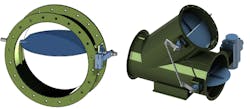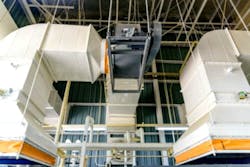Key Highlights
- Industrial dampers remove hazardous fumes, heat, and dust, protecting workers from respiratory diseases and fire hazards.
- Selecting the right type of damper—e.g., volume control, backdraft, or refractory dampers—is critical for managing airflow in foundry conditions.
- Proper placement near heat sources and hazardous zones ensures effective exhaust and prevents contamination of clean areas.
- Routine maintenance keeps dampers functioning correctly and to prevent safety issues.
Metal fumes, silica, carbon monoxide, dust, and formaldehyde are just some of the hazardous particles to be found airborne in foundries. Inhaling them puts workers at risk of serious diseases, including lung cancer and silicosis, making airflow control absolutely essential for metalcasting operations and their managers.
Industrial dampers are critical to keeping air moving properly and ensuring harmful fumes are exhausted, creating an environment where workers can operate safely. Knowing how to choose and position these dampers, while also maintaining them, helps facilities meet efficiency goals and occupational safety standards.
Controlling how air flows through these facilities helps protect workers and equipment from harm. Without this balance, toxic fumes and particles, along with heat, can build up and create risks that range from respiratory diseases to fire hazards. Industrial dampers manage these risks by regulating how air moves through ventilation and air pollution control systems.
Some of their essential benefits include:
- Improved heat and hazardous fume removal;
- Enhanced HVAC system efficiency;
- Minimal dust accumulation on equipment;
- Compliance with occupational health and safety standards; and,
- Flexibility to adjust airflow as conditions change.
Types of dampers in foundries
These industrial facilities face particular airflow challenges, like extreme heat and hazardous fumes, making it important to select the right type of damper. A few different types used in foundry settings include:
Volume control dampers. Wafer, butterfly, and other volume control (VCD) dampers regulate the amount of air flowing through different sections of the ventilation system, balancing airflow across the foundry and ensuring that high-heat or high-dust areas receive proper ventilation.
Backdraft and isolation dampers. Backdraft dampers prevent air from moving in the wrong direction, preventing fumes or hot air from entering clean areas. Isolation dampers, like guillotine or slide gate dampers, allow specific sections of a duct system to be shut off, making emergency containment or maintenance easier and safer.
High-temp capabilities and refractory dampers. High-temperature and refractory dampers are specifically designed to withstand the extreme heat and corrosive conditions found in melting and casting areas. Constructed from heat-resistant materials and lined with refractory insulation, these dampers maintain structural integrity and reliable airflow control even in continuous, high-temperature operations.
Motorized or automated dampers. These adjust airflow in real time based on process demand, pressure, temperature, or other factors, reducing the need for manual adjustments and maintaining consistent air quality.
Proper placement and sizing
Installing dampers correctly matters just as much as choosing the right type. Improper placement can create stagnant air zones or over-pressurized ducts, reducing safety and efficiency.
Dampers positioned near sources of fumes and dust or heat, like furnaces or casting areas, properly exhaust hazardous air to keep work zones safe. VCDs are particularly effective in these main ducts, allowing for accurate airflow regulation to balance different foundry areas.
Installing backdraft dampers in locations where air could potentially reverse, such as connections between multiple ventilation zones, prevents heat or contaminated air from moving backward to cleaner sections. Isolation dampers placed near branch points or equipment that may need to be shut off for maintenance or emergencies keep systems and workers protected.
Any duct that passes through fire-rated walls or ceilings should include fire and smoke dampers that can automatically close during a fire. Motorized or automated dampers work well in areas that require dynamic adjustments, like high-heat operations or chemical processing zones.
Sizing dampers correctly helps ensure consistent performance and accuracy for controlling airflow. An undersized damper can restrict airflow, while an oversized damper reduces control precision. Considering factors like duct geometry and system layout helps to minimize air turbulence and avoid pressure drops, while maintaining even air distribution throughout the foundry.
Maintenance and safety checks
Once dampers are in place, keeping them operating and in good condition requires routine maintenance. Foundries expose this equipment to dust and heat, while also involving nonstop operation that can wear down industrial dampers. Regular maintenance helps to ensure proper airflow and reduces serious safety risks to workers.
Consistent, routine inspections are the backbone of maintenance, providing opportunities to catch small issues early and prevent major safety problems. Common routine maintenance tasks include:
- Checking blades and frames for corrosion or warping that may block airflow or stop blades from sealing properly;
- Cleaning dust and debris from moving parts to prevent jams and help motors or actuators run without issues;
- Making sure dampers open, close, and adjust easily without sticking, lagging, or grinding responses;
- Testing automated systems regularly to confirm that certain components (sensors, actuators, control signals) work as intended;
- Verifying that airflow direction and volume stay consistent, especially in high-dust or high-heat zones;
- Inspecting seals and gaskets to prevent leaks or backflow of contaminated air;
- Tracking and logging every inspection and repair in a maintenance journal to keep the record organized and compliant with safety standards;
- Training staff to recognize warning signs, like unusual sounds or sudden temperature spikes, so issues are flagged quickly.
Safeguarding workers
Industrial dampers create safe and compliant foundry environments, removing particles, heat, fumes, and other airborne hazards and protecting workers from harm. Effective damper management comes down to three essential objectives: choosing the right type, placing it strategically, maintaining it regularly. These steps ensure that ventilation systems perform as intended while meeting strict occupational safety standards.
In a demanding setting like a foundry, there’s little room for error. A well-designed damper system safeguards worker health and keeps operations running reliably. It’s a straightforward investment for long-term operational stability and maximum safety.
About the Author
Sammy Kolker
Sales and Marketing Manger
Sammy Kolker is the sales and marketing manager for Kelair Dampers, which specializes in the design and production of industrial and high-temperature dampers for demanding air and gas control applications.


